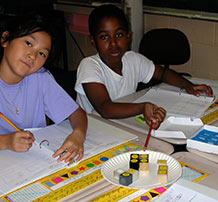How can we sort cubes that are all the same size?
2. Sort the cubes
Distribute a set of 8 cubes to each group. Challenge the groups to sort the cubes in at least 3 different ways. Remind students to record each grouping.
In the previous Materials session, students focused exclusively on the materials from which the cubes are made, and generated a list of words that describe the materials. In this session, students may sort and group the cubes in any logical way.
Likely cube groupings include the following:
- By weight: groups of heavy, medium, and light cubes; or just heavy cubes and light cubes
- By material type: groups of wood, plastic, and metal cubes
- By property: shiny cubes and dull cubes; smooth cubes and rough cubes; transparent cubes and opaque cubes

A sorting can result in the set of 8 cubes being divided into two, three, or possibly more subgroups. Encourage students to account for all the cubes in each sorting, even if it requires making a group called “None,” “Other,” “Miscellaneous,” or “Something Else.”
If students run out of ideas, suggest that they consult the class chart, looking for properties that are listed under two or more materials. Also encourage them to think about categories of descriptions — such as color, odor, texture, hardness, luster, and temperature — and that they label each of their 3 groupings with a similar “sorting word.”
- How are you sorting these?
- What rule are you using?
- What is a word for this characteristic?
Detours. Expect some category confusion. Children this age often conflate such properties as texture, luster, and opacity. They might, for example, create a grouping that sorts cubes according to whether they are “Smooth,” “Shiny,” or “Transparent.” In this case, you might agree that the grouping sorts the cubes by some broad category like appearance, or you might move the students toward some finer discriminations by asking, e.g.,
- What is the opposite of smooth? What is the opposite of shiny?
- What are you really talking about here? The way the cubes look or the way that they feel?
- Do these cubes belong in the same grouping? Yes? Then what is the name of the group?



